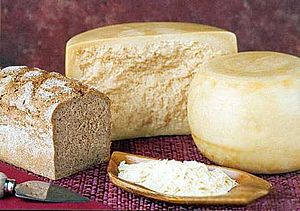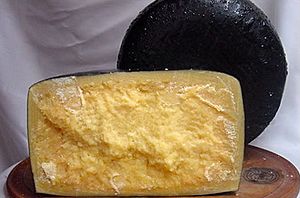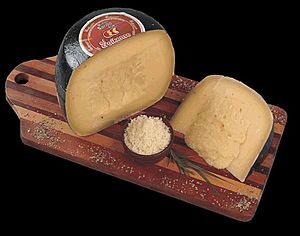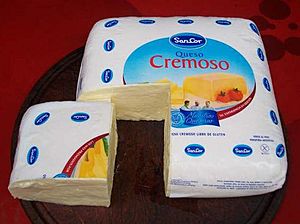Argentine cheese facts for kids

Argentine cheese is the most popular dairy food made in Argentina. This makes Argentina the second biggest cheese maker in Latin America and one of the top 10 in the world! People in Argentina also eat a lot of cheese, about 12 kilograms per person each year. Most of this cheese is made in the provinces of Córdoba, Santa Fe, and Buenos Aires. These areas are in the Pampas region, which is in the central and east-central parts of the country.
Contents
History of Argentine Cheese
In the 1700s, during the colonial times, two very old Argentine cheeses were created: Tafí del Valle and Goya. These, along with Chanco from Chile, are the oldest cheeses made in the Southern Cone part of South America. Tafí del Valle cheese is the oldest in Argentina. It started in the city of the same name in Tucumán. Many believe Jesuit missionaries first made it. Goya cheese was created in the city of the same name in Corrientes. These cheeses are special because they have almost 300 years of history, just like tequila from Mexico or pisco from Peru.
Modern Argentine cheesemaking really grew because of the big wave of European immigrants in the late 1800s and early 1900s. Many people from Italy came to Argentina. They brought their cheese-making skills and tried to make their home country's cheeses here. Some famous Argentine cheeses that came from this time include Reggianito, Sardo, Cremoso, Provoleta, and Pategrás.
How Argentine Cheese is Made
The dairy industry in Argentina is very advanced. It's one of the most modern in Latin America. Cheese is the most produced dairy item, using about 45% of all the milk made in the country. This puts Argentina among the top 10 cheese-producing countries worldwide and second in Latin America, after Brazil.
More than half of Argentina's cheese is soft cheese. Cremoso is the most popular soft cheese eaten in the country. Semi-hard cheeses make up about 30% of production, and hard cheeses make up 15%.
Most cheese production happens in the Pampas region. This area was greatly influenced by the European immigrants who arrived in the late 1800s and early 1900s. The main provinces that make cheese are Córdoba, Santa Fe, and Buenos Aires. Other provinces like La Pampa, Entre Ríos, and San Luis also produce some cheese.
Argentina makes a lot of high-quality cheese, so it doesn't need to import much. Most cheese imports (between 2,000 and 8,000 million tonnes) come from Brazil and Uruguay. Argentina exports a lot of cheese too, mainly to Brazil (43% of all exports in 2011). Other countries that buy Argentine cheese include Venezuela, Russia, Mexico, Chile, and South Korea.
Argentina also eats the most cheese in Latin America, about 12 kilograms per person each year. Because people started eating more cheese, production grew a lot in the 2000s. It went from 430,955 tonnes in 2001 to 508,000 tonnes in 2009. Cheese eating also increased from 8.3 kg per person in 2003 to 12.4 kg per person in 2012.
Types of Argentine Cheeses
Hard Cheeses

- Goya — This is one of Argentina's oldest cheeses. It was made by Gregoria Morales in the late 1700s in the province of Corrientes. People called her "Goya," so the cheese and the town where she lived got that name. By 1840, Goya cheese was very popular in Buenos Aires. It's now a classic part of Argentine culture.
- Reggianito — This popular cheese is a type of Grana cheese. It's made from cow's milk, mostly in the provinces of La Pampa, Buenos Aires, Santa Fe, Córdoba, and San Luis. Reggianito is based on Italian hard cheeses like Parmigiano Reggiano and Grana Padano. Its name means "Little Reggiano" because it's made in smaller wheels and aged for only 5–6 months. It's the most important hard cheese in Argentina, as it's the most exported and most eaten.
Semi-hard Cheeses

- Chubut — This cheese is named after the Patagonian province of Chubut. Welsh immigrants created it in the mid-to-late 1800s. It became popular thanks to the Magnasco company, which started making it in Río Cuarto, Córdoba. Chubut cheese is often eaten with quince paste (called dulce de membrillo). This combination is known as queso y dulce (cheese and jam) or vigilante, a typical Argentine dessert.
- Holanda — Also known as Mar del Plata, this cheese was created in the coastal city of the same name. It's a semi-fat cheese made from partially skimmed cow's milk and aged for 4 to 12 months. It's light yellow with small holes and often has a red or yellow rind. Because of its rind, it's also called Cáscara Colorada ("red rind"). It's similar to Edam cheese, adapted by European immigrants.
- Pategrás — This is the most popular semi-hard cheese made in Argentina. It's made from pasteurized cow's milk. It has a white-yellowish color, a firm texture, and is elastic. Pategrás has a sweet taste and a pleasant smell. Its rind is smooth and often covered in paraffin or colored red or yellow. There's also a "pategrás sandwich" or "queso barra" variety, which is more elastic and has no holes, perfect for slicing thin.
- Provoleta — This is a local version of Provolone cheese. It's usually grilled and eaten as a starter when people have a barbecue (called asado). An Italian immigrant named Natalio Alba created it in the 1940s. He wanted a cheese that could be cooked as part of the asado. In 1955, Provoleta was officially added to the Food Code as Queso Provolone Hilado Argentino (Argentine Stretched Provolone Cheese).
- Sardo — This yellowish-white cheese is similar to Pecorino Romano. However, Pecorino Romano is made from sheep's milk, while Sardo is made from cow's milk. When Sardo is young, it's a semi-hard cheese with a soft, sweet taste. As it gets older, it becomes harder and has a stronger flavor. Sometimes, Sardo can even be considered a hard cheese.
- Tafí del Valle — This cheese from Tafi del Valle, Tucumán, is the oldest Argentine cheese. It was created in the 1700s, and many believe Jesuit missionaries were behind it. Like Goya cheese, Tafí del Valle cheese has almost 300 years of history. Every year, the city of Tafí del Valle hosts the National Cheese Festival (Festival Nacional del Queso).
Soft Cheeses

- Cremoso — Also known as Mantecoso ("buttery") or Fresco ("fresh"), Cremoso cheese is a very moist cheese. It's made from whole milk, with or without cream, and uses special bacteria and enzymes. Cremoso is white-yellowish, with a sweet and slightly sour taste. It has a soft, somewhat elastic texture and is aged for 20 to 30 days. It comes from cheeses made in Italy and Switzerland. As its name suggests, Cremoso can be elastic or creamy and sticky. It's the most popular cheese in Argentina because it melts very well.
- Cuartirolo — The Argentine Food Code describes Cuartirolo as a very moist product made from whole milk, using bacteria and enzymes. Some experts think Cuartirolo is basically the same as Cremoso cheese.
- Quesillo — This is a traditional cheese made by hand in the Argentine Northwest. It's mainly produced in the provinces of Catamarca and Tucumán, but also in Santiago del Estero, Salta, and Jujuy. It's a fresh cheese made by "spinning" the cheese paste. Quesillo's history goes back to the dairy work of the local people in the region. It's a traditional product often made by women, using recipes passed down through generations. In 2017, Quesillo was officially added to the Argentine Food Code. This means it can now be produced and sold more widely.

